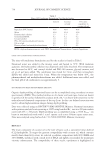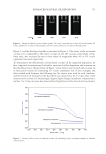663 MAPPING PROTEIN CROSS-LINKS IN HUMAN HAIR DISCUSSION Intermediate filaments are a key repeating structural unit of the human hair shaft, and their stability depends on cross-links both within filaments and between filaments via a network that extends through the interfilament matrix. The premise for this study was that the protein–protein cross-link network underpins health- and consumer-relevant physicomechanical properties of hair and that some cross-links are more important than others in their contribution to these properties. Location of individual cross-links is valuable to better understand the role of specific cross-links on properties and to investigate macromolecular relationships within and between keratin intermediate filaments. In the last few decades, significant progress has been made in understanding the exact structure of the intermediate filaments through insights gained via amino acid analysis, computer modeling, x-ray fiber diffraction and protein crystallography, electron microscopy, and chemical cross-linking methods (2,9). These methods have helped us understand the structural detail of the hierarchical structure of keratins into heterodimers, tetramers, and 32-chain intermediate filaments. Currently, however, widespread pinpointing of the exact location of cross-links within and between the intermediate filament proteins is still very challenging. In this proof-of-concept study, we have, for the first time, applied mass spectrometric techniques to detect native cross-links present within the human hair cortex and to map the exact location of these cross-links within the proteins. The use of mass spectrometry in protein cross-links has challenges, including, but not limited to, low abundance of cross-linked peptides, fragmentation of the cross-link peptides by the mass spectrometer, and the lack of automated data analysis for cross-linked peptides (5,6). Therefore, most of the work published on native protein cross-links to date involves a noncomplex mixture of proteins. Extending this technology to a complex hair shaft proteome comes with challenges in data complexity. Although disulfide bonds are the best characterized cross-links between keratin proteins in hair, their analysis in complex samples is complicated because typical proteomics approaches break disulfide bonds to Table II List of Lysinoalanine Cross-Links Found in Human Virgin Hair Shaft Digest With q Smaller Than 0.05 Scan number q value Peptide 1 Peptide 2 Protein 1 Protein 2 8040 0 .ADLETNAEALVQEIDFL KSLYEEEICLLQSQ[0.98] ISETSVIVKMDNSR TMQDSVEDF KTKYEEEINK HUMAN_K4 HUMAN_K82 19330 0 .GPC[57.02] RPGGGRGLRALG CLGSRSLCN[0.98] VGFGRPR KN[0.98]HEEEVN [0.98]TLR HUMAN_K82 HUMAN_K34 18602 0 .KDVDCAYLRKSDLEANVE ALVEESSFLR KVLEEVDQR HUMAN_K85 HUMAN_K25 17055 0.030 .N[0.98]Q[0.98]YEALVETN [0.98]RREVEQWFA TQTEELNKQVVSSSEQ LQSYQAEIIELR SQILSVKSHCLK HUMAN_ K33B HUMAN_K80 17824 0 .SQYEALVETN RREVEQWFATQ[0.98] TEELNKQVVS SSEQLQSYQAEIIELR SRQFTCKSGAAAK HUMAN_ K33A HUMAN_K71
Figure 5. Mass spectrometric characterization of intermolecule lysinoalanine cross-links found between keratin 33B and keratin 80 within a tryptic digest of hair shaft- extracted proteins. 664 JOURNAL OF COSMETIC SCIENCE
Purchased for the exclusive use of nofirst nolast (unknown) From: SCC Media Library & Resource Center (library.scconline.org)






































































































































